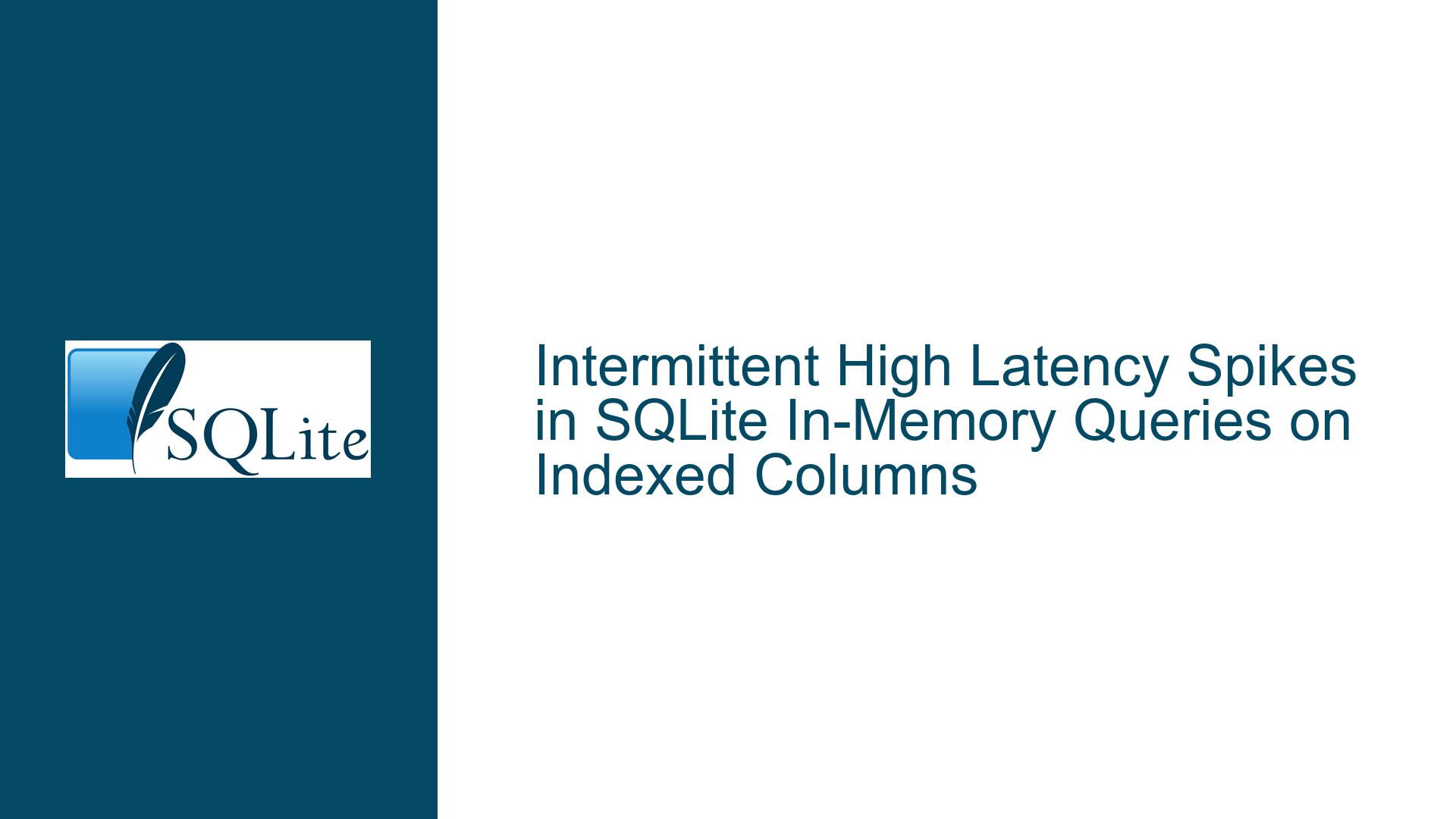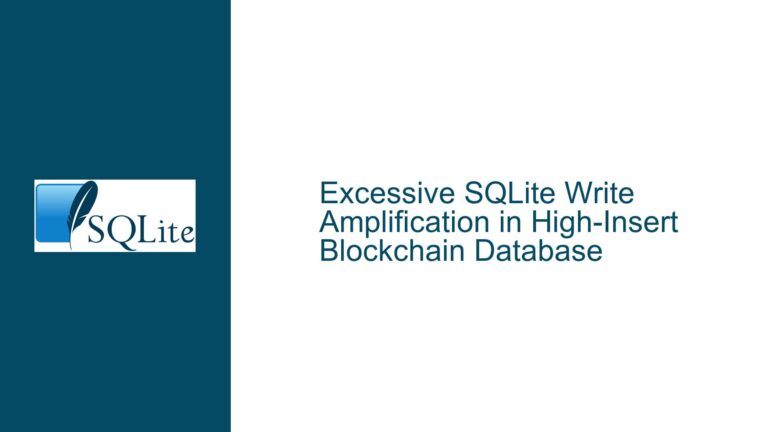Intermittent High Latency Spikes in SQLite In-Memory Queries on Indexed Columns
Understanding Variable Execution Times in SQLite In-Memory Queries on Large Datasets
In-Memory SQLite Query Performance: Baseline Behavior vs. Latency Outliers
SQLite in-memory databases are designed for high-performance operations by eliminating disk I/O overhead. When working with a table containing 10 million records and an indexed column, the expectation is consistently low-latency query execution. However, sporadic execution time spikes—such as jumps from a baseline of 2 ms to over 10 ms—indicate systemic or environmental factors disrupting deterministic performance.
The core issue arises from the interaction between SQLite’s internal mechanisms, hardware resource management, and operating system (OS) behavior. Even with indexed queries, minor variations in page retrieval, caching hierarchies, and CPU scheduling can create latency outliers. These outliers are not inherently caused by SQLite’s query planner or indexing logic but by external layers of abstraction that manage memory, CPU cycles, and process prioritization.
For example, a query that normally traverses 18 indexed pages might occasionally require 20 pages due to transient cache evictions. While this difference seems negligible, it can amplify latency when compounded with CPU frequency scaling, thread scheduling delays, or background processes. The problem is exacerbated in multi-language environments (C#, C++, Rust) where runtime-specific memory management or garbage collection (GC) might falsely appear as culprits. However, the persistence of spikes across these environments suggests a deeper layer—such as the OS kernel, CPU architecture, or SQLite’s own memory-mapped file handling—is responsible.
Contributors to Non-Deterministic Query Latency in Resource-Constrained Systems
1. Multi-Layer Caching Hierarchies and Page Faults
SQLite relies on a page cache to store frequently accessed database pages. In-memory databases use sqlite3_mem_methods for dynamic memory allocation, but the OS still manages virtual memory. Even with sufficient RAM, the OS may swap pages between physical memory and disk due to memory pressure from other processes or conservative swap configuration. This is rare for dedicated in-memory setups but possible if the OS’s memory manager treats SQLite’s allocations as non-critical.
Additionally, CPU caches (L1/L2/L3) play a role. A query that fits entirely within L3 cache will execute faster than one requiring frequent access to main memory. When concurrent processes compete for cache space, SQLite’s working set may be partially evicted, forcing cache line refetches during subsequent queries.
2. CPU Frequency Scaling and Heterogeneous Core Architectures
Modern CPUs use dynamic frequency scaling (e.g., Intel Turbo Boost, AMD Precision Boost) to balance power efficiency and performance. A query executing during a frequency ramp-up may temporarily experience lower IPC (instructions per cycle). On ARM-based systems with BIG.LITTLE cores (e.g., Apple M1/M2, Qualcomm Snapdragon), the OS scheduler may migrate the SQLite process between high-performance and efficiency cores, introducing variable instruction latency.
For instance, a query taking 2 ms on a P-core might require 8 ms on an E-core due to reduced clock speeds and simpler pipeline architecture. This is particularly problematic in mobile or laptop environments where power-saving modes are aggressive.
3. Memory Allocation Fragmentation and Garbage Collection Overheads
While SQLite itself does not employ garbage collection, the underlying memory allocator (e.g., jemalloc, tcmalloc, OS default) may introduce fragmentation. Repeated allocations and deallocations for prepared statements or temporary query results can create non-contiguous memory regions, forcing the allocator to spend extra cycles searching for free blocks. In Rust, the ownership model reduces heap fragmentation, but manual memory management in C++ or C#’s unsafe code blocks can still lead to suboptimal allocation patterns.
4. Prepared Statement Recompilation and Schema Lock Contention
If the application does not reuse prepared statements, SQLite must reparse and reoptimize the query on each execution. While this cost is usually negligible, it becomes significant under high concurrency or when schema modifications (e.g., ALTER TABLE) occur frequently. Schema locks block query execution until metadata updates are committed, creating latency spikes during concurrent read/write workloads.
5. Background OS Services and Hardware Interrupts
The OS periodically handles interrupts for network packets, storage I/O, and peripheral inputs. These interrupts preempt the SQLite process, delaying query execution. Tools like perf on Linux or ETW (Event Tracing for Windows) can correlate latency spikes with specific system events.
Mitigating Execution Time Variability in SQLite In-Memory Workloads
Step 1: Isolate SQLite Memory from OS Page Swapping
Prevent the OS from paging SQLite’s in-memory database to disk:
- Linux: Use
mlockall(MCL_CURRENT | MCL_FUTURE)to lock all current and future memory allocations into RAM. Ensure the process has theCAP_IPC_LOCKcapability. - Windows: Call
VirtualLock()on the database buffer. Note that Windows enforces a strict limit on locked memory per process (default: 30–50 MB). - macOS: Use
madvise()withMADV_FREEorMADV_FIXEDto advise the kernel against reclaiming pages.
Validate memory locking with pmap -X <PID> (Linux) or vmmap (macOS) to confirm that all database regions are marked as “locked” or “non-swappable.”
Step 2: Pin SQLite Process to High-Performance CPU Cores
Restrict the SQLite process to P-cores on BIG.LITTLE systems:
- Linux: Use
taskset -c 0-3 ./sqlite_appto bind to cores 0–3 (assuming these are P-cores). - Windows: Leverage the
SetProcessAffinityMaskAPI or PowerShell’sSet-ProcessAffinitycmdlet. - macOS:
caffeinatecan temporarily prevent idle sleep but lacks core pinning; usehwprefsorcpubindvia third-party tools.
Disable CPU frequency scaling:
echo performance | sudo tee /sys/devices/system/cpu/cpu*/cpufreq/scaling_governor # Linux
powercfg -setacvalueindex SCHEME_BALANCED SUB_PROCESSOR IDLEDISABLE 1 # Windows
Step 3: Optimize Memory Allocation and SQLite Page Size
Override the default memory allocator with a real-time variant:
- Link against
jemallocwith--enable-profand configurelg_chunkto match SQLite’s page size (default: 4096 bytes). - In C++, use
std::pmr::monotonic_buffer_resourcefor temporary query results to minimize heap fragmentation.
Adjust SQLite’s page size to align with CPU cache lines (typically 64 bytes):
PRAGMA page_size = 4096; -- Match allocator and cache line
PRAGMA cache_size = -200000; -- 200,000 pages (~781 MB for 4096-byte pages)
Step 4: Audit Prepared Statement Reuse and Schema Locks
Ensure all queries are parameterized and reused:
// C# example
using (var cmd = new SQLiteCommand("SELECT * FROM tbl WHERE id = @id", conn)) {
cmd.Parameters.AddWithValue("@id", 42);
// Reuse 'cmd' for subsequent queries with different parameters
}
Monitor schema changes with sqlite3_trace_v2() and avoid concurrent DDL operations during peak query loads.
Step 5: Profile Hardware-Level Metrics During Query Execution
Use low-level profiling tools to identify microarchitectural bottlenecks:
- Linux:
perf stat -e instructions,cache-misses,cycles ./sqlite_app - Windows: Use Intel VTune or Windows Performance Analyzer (WPA) to track cache miss rates and branch mispredictions.
- macOS:
sudo sample ProcessNameto capture call graphs and CPU usage.
Cross-reference high-latency queries with increased cache-misses or branch-misses to pinpoint CPU-bound issues.
Step 6: Evaluate Kernel Bypass and Real-Time Scheduling
For bare-metal deployments, consider a real-time OS (RTOS) or Linux with SCHED_FIFO scheduling:
sudo chrt -f 99 ./sqlite_app # Run with FIFO scheduler at priority 99
This minimizes preemption by non-critical processes but requires root privileges and careful system tuning.
Step 7: Validate In-Memory Database Configuration
Ensure the database is truly in-memory and not backed by a temporary file:
ATTACH DATABASE ':memory:' AS memdb; -- Pure in-memory
-- NOT file:memdb?mode=memory&cache=shared (tmpfs-backed)
Verify using lsof -p <PID> (Linux/macOS) or Process Explorer (Windows) to confirm no file descriptors are open for the database.
Step 8: Analyze SQLite Opcode Consistency
Dump the VDBE (Virtual Database Engine) opcode for the query to ensure optimization stability:
EXPLAIN SELECT * FROM tbl WHERE indexed_col = 123;
Look for variable SCAN vs. SEARCH patterns, which indicate index usage fluctuations. Rebuild the index if opcodes show full-table scans during spikes:
REINDEX tbl_indexed_col;
Step 9: Disable Debugging and Instrumentation Overheads
Ensure SQLite is compiled with optimization flags and without debugging:
./configure CFLAGS="-O3 -DSQLITE_THREADSAFE=0 -DSQLITE_DEFAULT_MEMSTATUS=0" # Minimal build
Disable profiling hooks and debug utilities:
sqlite3_config(SQLITE_CONFIG_URI, 1);
sqlite3_config(SQLITE_CONFIG_MEMSTATUS, 0); -- Disable memory tracking
Step 10: Leverage Statistical Analysis for Baseline Thresholds
Calculate the 99th percentile latency using tools like prometheus + grafana or custom scripts. Establish a performance baseline and trigger alerts only when spikes exceed statistically significant thresholds (e.g., μ + 3σ).
By addressing these factors systematically, developers can reduce the frequency and magnitude of latency spikes in SQLite in-memory queries. However, complete elimination is impractical due to the inherent non-determinism in modern multi-layered computing systems. The goal is to stabilize performance within an acceptable envelope rather than achieve perfect consistency.






